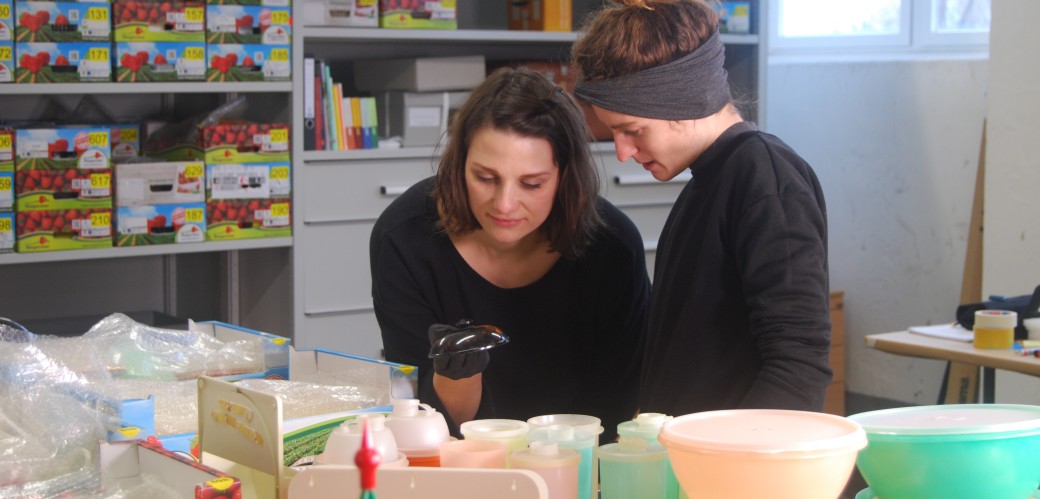

In September 2018 the project “Plastics – a modern material in a cultural historic context (KuWerKo)” -sponsored by Federal Ministry for Education and Research (BMBF) got underway. Over the next four years the LVR-Industriemuseum in co-operation with the University of Applied Sciences in Cologne (Institute for Conservation Science CICS) and the University of Stuttgart (Institute for Plastics Technology, IKT) will carry out research on the collection from the Deutschen Kunststoff-Museum (German Plastics Museum), which has been on permanent loan in Oberhausen since June 2017. One objective is to compile standards which could also assist other museums: for example in identifying materials, determining measures for preventative conservation or nomenclature.

Today a life without plastics is inconceivable: Plastic is the material of the 20th and 21st centuries. Since 1983 the amount of plastics sold has even exceeded that of steel. Plastic therefore is a material witness of our time and both then and now strongly shapes our culture: From a cheap – therefore inferior – substitute for expensive natural products such as ebony, ivory or tortoise shell right up to the coveted cult or high-tech item. But how exactly has the material influenced our cultural development? What do the products reveal about us through their design, production technique and materiality and how can we preserve them for posterity? The information contained in an object in most cases greatly exceeds the visible features so that contextualisation often leads to a significant increase in relevance which needs to be exposed and documented. In order to decode and document the language of the items, it is essential to preserve them. Contrary to their image as non-decomposable waste, plastics prove to be difficult patients in respect of their long-life cycle.

Small, transparent pearls form on the surface giving the impression that the plastic is perspiring. Indeed during the aging process certain substances such as plasticizers migrate out of the modern material, this does not, however, take place without leaving a trace: the material becomes sticky, brittle and loses its shape. Such aging processes present restorers with still unresolved problems and open up a wide field in which a great deal of research is still needed. Against this background it seems all the more important to document and interpret the information which plastic products provide us with in good time.
To get to the bottom of questions like these, the Deutsche Kunststoff Museums Verein (Association of Friends) is making its collection comprising some 20,000 items available for the research project KuWerKo. The aim is to highlight the enormous social, cultural and economic change which has been brought about by this material using individual items which are regarded as icons made of plastic – either due to their design, their innovative character or their effect on us.
In the research project “Plastic – a modern material in a cultural historic context”, an interdisciplinary team of researcher will over the next four years learn to read the language of these objects and preserve it for posterity.
Those involved are the Landschaftsverband Rheinland (LVR), the Institut für Kunststofftechnik (IKT) (Institute for Plastics Technology) at the University of Stuttgart and the Institute for Restaurierungs- und Konservierungswissenschaft (CICS) (Institute of Conservation Sciences). KuWerKo is sponsored by the Federal Ministry for Education and Research (BMBF).
Research project:
KuWerKo – Kunststoff - ein moderner Werkstoff im kulturhistorischen Kontext (Plastic – a modern material in a cultural historic context)
Director:
Prof. Dr. phil. Friederike Waentig
Faculty:
Fakultät für Kulturwissenschaften (Faculty for Cultural Sciences)
Institute:
CICS – Cologne Institute of Conservation Sciences
Institute for Restoration and Conservation Sciences
Participants:
LVR-Industriemuseum
IKT - Institut für Kunststofftechnik Stuttgart, Uni Stuttgart (Institute for Plastics Technology Stuttgart University)
CICS - Cologne Institute of Conservation Sciences, Technical University Cologne
Funding Authority:
BMBF - Bundesministerium für Bildung und Forschung (Federal Ministry for Education and Research)
Duration:
September 2018 - August 2022